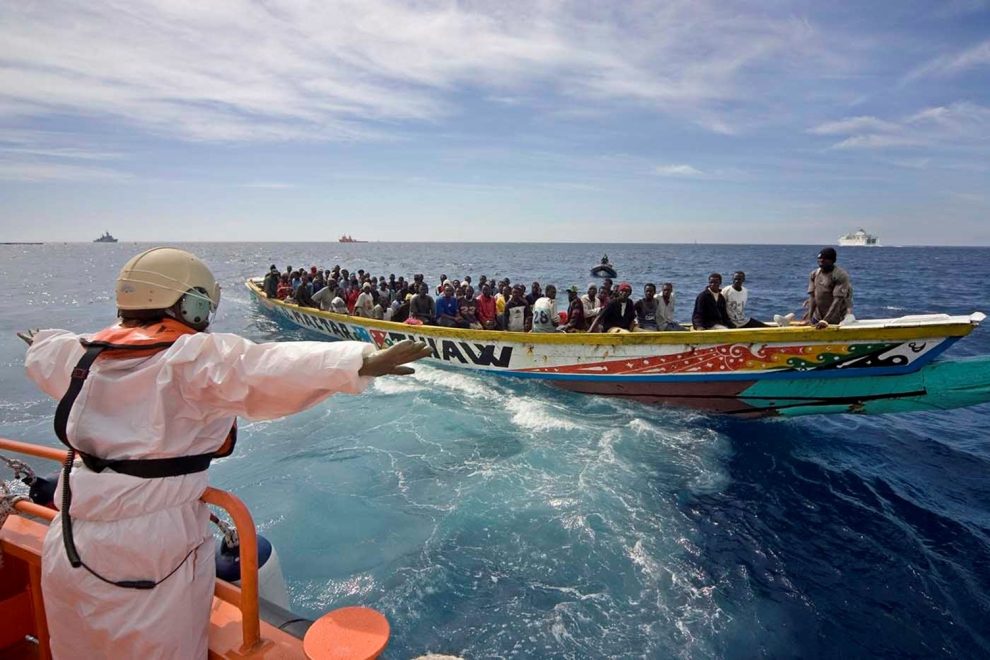Africa is said to be one of the most youthful continents on earth, with at least 75% of its population under the age of 35, and hungry for economic success and prosperity. The rising number of Africans, mostly young people, making the hazardous trip across the Mediterranean in a desperate bid to enter Europe illegally, is therefore a cause of high concern. Desmond Davies looks at why the African youth – who make up most of the unpalatable global headlines about those perishing at sea – are so desperate to flee a continent which, if economic statistics are anything to go by, could hold a brighter future for them.
According to a report released in September by the International Office on Migration (IOM), since 2000 over 40,000 mainly young people have lost their lives as they try to illegally cross over into Europe from North African countries along the Mediterranean Sea. During the same period a further 3,000 died in the Saharan Desert and Indian Ocean. The IOM said that these victims were part of “an epidemic of crime and victimisation”.

The authorities in Italy, one of the main destinations for migrants from across the Mediterranean Sea, have said that the rising wave of illegal migration has reached “Biblical proportions”. In 2013, according to the UN High Commissioner for Refugees (UNHCR), some 63,0000 – and not just from sub-Saharan Africa – made the dangerous crossing. In the first six months of this year over 60,000 had already reached Italy and its Coast Guard intercepts boats crammed with illegal migrants almost on a daily basis.
The IOM report, compiled under its Missing Migrants Project, said Europe was the world’s most dangerous destination for “irregular” migration, costing the lives of over 3,000 migrants since May 2014. Besides counting fatalities, the Missing Migrants Project is part of a broader effort to use social media to engage communities around the world.
The Missing Migrants Project hopes to “lend a powerful voice of deterrence to keep future victims from embarking on these dangerous journeys”. The IOM spokesman Leonard Doyle says: “People are already looking for information about missing migrants on Facebook. We know as well that people are trafficked around the world using Facebook and other social media…We want to turn #MissingMigrants into a powerful voice to warn future migrants against taking these high-risk journeys. It is not doing it with a poster or a radio spot, but with the most persuasive means out there – the voices of survivors and the family members of missing migrants.”
The motivations of Africa’s desperate migrants are varied. For those from East Africa and the Horn of Africa, the motivation is to flee conflict in the region while those from West and Central Africa tend to be leaving for economic reasons.
Criminals are lurking in this milieu to take advantage of people in despair. The UN Office on Drugs and Crime (UNODC) noted earlier this year: “Each year, some 55,000 migrants are thought to be smuggled from East, North and West Africa into Europe, generating about $150 million in revenues for criminals.”
The IOM report explains that people smugglers are difficult to track down or stop because “security, border control and immigration authorities may be complicit enablers of the smuggling business. Where trafficking exists, in some cases authorities have also been implicated.”
The IOM said that most migrant deaths occurred as a result of “deliberate mistreatment, indifference or torture by smugglers, or misadventures by migrants themselves”. It went on: “Along all routes, cases of sexual violence against female migrants are commonly reported – particularly concerning those from the Horn of Africa – as well as explicit sexual exploitation and frequent disappearances of girls and women.”
The UN and AU must intervene
At September’s annual United Nations General Assembly (UNGA), the outspoken Gambian President Yahya Jammeh dropped a bombshell on the issue of African migrants dying at sea, calling the situation “genocide”.
Without holding back, he told the UN in his speech to the UNGA: “The UN must conduct a full and impartial investigation into the man-made sinking, and capsizing of these boats carrying young Africans to Europe. If these boats are able to cross the Atlantic Ocean and the Mediterranean Sea only to sink on European coasts, we must find out what deadly mysterious force exists on the European Mediterranean coasts that causes boats carrying these young Africans to disintegrate and sink [usually] upon arrival…”
He added: “Enough is enough and the UN must intervene and intervene quickly or else we will all live to regret our failure to take appropriate action at the right time.”
That said, the other question being asked is: What is the African Union (the continent’s umbrella body of unity) doing to deal with what is undoubtedly a major social problem for the whole of Africa?
The illegal immigrants from sub-Saharan Africa are overwhelmingly young males of working age, with around 85% of them being between the ages of 18 and 35. Why are these ripe-of-age, yet impoverished young people taking immeasurable risks to find their way to better standards of living in Europe?
When the African Union (AU) was launched in Durban just over 10 years ago, the continent’s leader made it clear that it was not going to be a continuation of the Organisation of African Unity (OAU) under a different name but an organisation that would drive and advance the development of the African people to unprecedented heights.
At the first session of the AU Conference of Ministers in charge of Social Development in Windhoek in October 2008, the politicians stressed that the AU’s social development programme should be “based on a human-centred approach that seeks to promote human rights and dignity”.
However, the Ministers noted: “…this aspiration is likely to be hampered unless the dire social developmental crisis facing the continent – reflected in, among others, a high burden of disease, lack of basic infrastructure and social services, inadequate health care and services; poor access to basic education and training; high illiteracy rates; gender inequality; youth marginalisation; and political instability in a number of countries – is sufficiently addressed.”
It was as a result of this that the AU developed a Social Policy Framework (SPF) for Africa. Among the 18 key issues that it focused on were youth, and migration. It was acknowledged that the high “unemployment and underemployment” of young people on the continent was a major challenge for African governments.
The document explained: “Most young people who work are employed in low-paying, temporary positions, working long hours under poor conditions, often with few, if any, protections. This type of work is likely to persist well into the future.
“Young people have become the street youth of Africa – hustling to make a living through the petty trading of fruit, telephone cards and other portable goods. Young people in sub-Saharan Africa are only second to [those in] South Asia in the extent to which they live in extreme poverty and hunger …Despite the expansions of democratic governance on the continent, and the value attached to youth participation in policy-making, contemporary youth organisations claim it is not meaningfully realised.
Young people voice concerns about how they are treated by governments – often more as a threat than a partner. Moreover, youth structures and processes are seldom sufficiently resourced and young people often lack the capacity or know-how to function independently or to implement programmes envisioned by policies,” the document added.
Given the above situation, is it any wonder that young Africans are ready to take the risk and make the rough crossing into Europe? The desperation of this generation of the continent’s young is palpable.
At the height of the Iraqi resistance to US forces after the invasion of Iraq in 2003, young Africans were ready to work for private security companies in the cauldron that was Baghdad for as little as $100 a month. But many returned home because they could not stand the heat. So, for those who might have tried Iraq, crossing the Mediterranean might seem a doddle.
Migration from Africa, despite the obstacles and the continent’s growing opportunities, will continue, as the AU acknowledges. This was recognised as far back as 2006, when the AU noted that out of 150 million migrants worldwide, 50 million were Africans.
Indeed, when Muammar Gathafi was in power in Libya, some 2.5 million sub-Saharan Africans emigrated to Libya because the country provided jobs and the government fully backed the AU project. But once Gathafi was ousted in 2011 by Western-backed rebels – who are now tearing the country apart – Africans with darker skins were no longer welcome.
The IOM report explained: “Nevertheless, the impression that Libya can provide good employment opportunities for sub-Saharan Africans continues to draw tens of thousands of migrants every year. Many have no intention to cross over to Europe when they first set foot from their countries of origin; however, a greater share are now crossing the Mediterranean, pushed out by the harsh and ill-treatment from authorities and locals in post-revolution Libya.”
It adds: “Moreover, competition for low-skilled jobs has increased with the larger flow of low-skilled migrants entering the country, meaning the availability of jobs is not always as strong as those arriving may have imagined.” But the report also adds that immigration from sub-Saharan African countries is also compounded by the high birth rate on the continent, which has 40 of the 50 countries with the highest birth rates in the world.
“The pressure these demographics pose for [African] economies, food security, physical security, services and facilities will be, and is already, huge. When compounded by rising inequalities in access to and opportunities in job markets, as well as an absence of equitable distribution of income and resources, it seems clear that the future management of this large, expectant population will be problematic to say the least,” says the IOM report, adding:
“One outcome that can be fully expected will be the compulsion to seek better opportunities outside sub-Sahara – out-migration. As long as such movement is restricted and illegal, irregular, clandestine and smuggler-managed movement will continue.”
The IOM believes that its report will begin to provide some clarity to what many consider to be a growing epidemic of crime against migrants. It says the report represents an initial step towards a more comprehensive account of what is happening to the victims and a wake-up call for governments.
“The paradox is that at a time when one in seven people around the world are migrants, we are seeing an extraordinarily harsh response to migration in the developed world,” said IOM director-general William L. Wing.
“Limited opportunities for safe and regular migration drive would-be migrants into the hands of smugglers, feeding an unscrupulous trade that threatens the lives of desperate people. We need to put an end to this cycle. Undocumented migrants are not criminals. They are human beings in need of protection and assistance, and deserving respect,” he added.
The IOM states that the dangers of illegal immigration should be constantly highlighted to serve as a deterrent: “Our message is blunt: migrants are dying who need not,” says IOM chief Wing, adding: “It is time to do more than count the number of victims. It is time to engage the world to stop this violence against desperate migrants.”
The IOM says that the true number of fatalities is likely to be considerably higher. Its report uses statistical data compiled by governments and other agencies, as well as NGOs and media sources, but collecting data on migrant deaths has never been a priority for most governments around the world.
“Although vast sums of money are spent collecting migration and border control data, very few agencies collect and publish data on migrant deaths,” says Frank Laczko, IOM Head of Research.
Many deaths occur in remote regions of the world and are never recorded. No organisation at the global level is currently responsible for systematically monitoring the number of deaths that occur. According to Laczko, data tends to be scattered, with a range of organisations involved in tracking fatalities. Some experts now believe that for every dead body discovered, there are at least two others that are never recovered.
Besides counting fatalities, the Missing Migrants Project is part of a broader effort to use social media to engage communities around the world. With September’s Malta shipwreck that left well over 500 migrants dead, IOM offices worldwide received calls and emails from family members across Europe and the Middle East seeking news about their missing relatives, many of whom have never been found, feared dead.
In all this, for young Africans, it is necessary for governments on the continent to counter poverty through economic development that would discourage young people from going abroad in search of economic opportunities. “The relationship between economic development, trade and migration is an important one,” as noted by the African Union’s Social Policy Framework.
Future social development in Africa will depend on, among others, the extent to which African Union member states are able to adopt and effectively implement the key recommendations of this Social Policy Framework. It is imperative, therefore, that the implementation and impact of the framework is effectively monitored and evaluated.
But until African governments address the serious situation of high youth unemployment, young people will continue to take the risk of trying to cross dangerous waters in search of what they believe will be better opportunities.
Source:



















